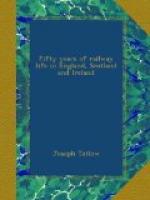This saloon merits a word or two. It was built in the year 1844, was originally the property of William Dargan, the well-known contractor and the promoter of the Dublin Exhibition of 1853, whose statue adorns the grounds that front the Irish National Gallery. Dargan made the Midland railway from Athlone to Galway, completed the work before the specified contract time (in itself a matter worthy of note), and on its completion in 1851, presented this saloon carriage to the company, which also, I think, deserves to be recorded. Thus, in 1891, it was nearly 50 years’ old and was handsome still. The panels were modelled on the old stage coach design, and a great bow window adorned each end. In the seventies and eighties it enjoyed the distinction of being the favourite carriage, on the Midland, of the Empress of Austria in her hunting days in Meath. This fine old carriage, now in its 75th year, does good work still. It has had a new under frame, its roof has been raised, and it looks good for another quarter of a century. Perhaps, granting an originally sound constitution, its longevity is largely due to the regular life it has led, never having been overworked, and having enjoyed many periods of rest.
Ballinasloe fair has two specially big days—Tuesday and Friday—the former devoted to the sale of sheep and the latter to cattle, though in fact its commerce in cattle, sheep, horses, pigs, calves, rams and goats, not to mention donkeys and mules, goes on more or less briskly throughout the whole week, Saturday being remnant day when jobbers pick up bargains. In 1891 the fair was not, and is not now, what it once was, which recalls the answer a witty editor of Punch once made to a friend. Said the said friend: “My dear fellow, Punch is not so good as it used to be.” “No, it never was,” came the quick rejoinder. But of Ballinasloe fair I cannot say it never was, for a hundred years ago, in Peggy O’Dowd’s time, in the west of Ireland it was the great event of the year, not only for the sale of flocks and herds, but also for social gatherings, fun and frolic, so at least I am told by the oldest inhabitant. An older account still, says these fairs were a time for games and races, pleasure and amusement, and eating and feasting, whilst another record describes them as places “where there were food and precious raiment, downs and quilts, ale and flesh meat, chessmen and chess boards, horses and chariots, greyhounds, and playthings besides.” It is curious that dancing is not mentioned, but dancing in the olden days in Ireland was not, I believe, much indulged in. Eighty years ago over 80,000 sheep entered the fair, and 20,000 cattle.




